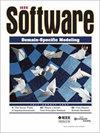需求工程和大型语言模型:专家小组的见解
IF 3
4区 计算机科学
Q2 COMPUTER SCIENCE, SOFTWARE ENGINEERING
引用次数: 0
摘要
作为一种通用技术,大型语言模型有望增强各种软件工程任务。但它们会对需求工程产生怎样的影响呢?本专栏对在德国汉诺威举行的 2023 年国际需求工程大会上的专家小组讨论进行了总结。本文章由计算机程序翻译,如有差异,请以英文原文为准。
Requirements Engineering and Large Language Models: Insights From a Panel
As a general-purpose technology, large language models promise to enhance various software engineering tasks. But how will they impact requirements engineering? This column offers a summary of an expert panel discussion from the 2023 International Requirements Engineering Conference in Hanover, Germany.
求助全文
通过发布文献求助,成功后即可免费获取论文全文。
去求助
来源期刊

IEEE Software
工程技术-计算机:软件工程
CiteScore
5.50
自引率
6.10%
发文量
182
审稿时长
6-12 weeks
期刊介绍:
IEEE Software delivers reliable, useful, leading-edge software development information to keep engineers and managers abreast of rapid technology change. Its mission is to build the community of leading software practitioners. The authority on translating software theory into practice, this magazine positions itself between pure research and pure practice, transferring ideas, methods, and experiences among researchers and engineers. Peerreviewed articles and columns by seasoned practitioners illuminate all aspects of the industry, including process improvement, project management, development tools, software maintenance, Web applications and opportunities, testing, and usability. The magazine''s readers specify, design, document, test, maintain, purchase, engineer, sell, teach, research, and manage the production of software or systems that include software. IEEE Software welcomes articles describing how software is developed in specific companies, laboratories, and university environments as well as articles describing new tools, current trends, and past projects'' limitations and failures as well as successes. Sample topics include geographically distributed development; software architectures; program and system debugging and testing; the education of software professionals; requirements, design, development, testing, and management methodologies; performance measurement and evaluation; standards; program and system reliability, security, and verification; programming environments; languages and language-related issues; Web-based development; usability; and software-related social and legal issues.
 求助内容:
求助内容: 应助结果提醒方式:
应助结果提醒方式:


